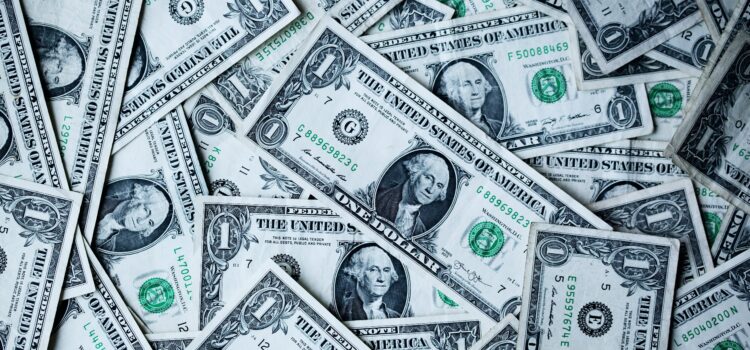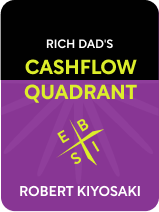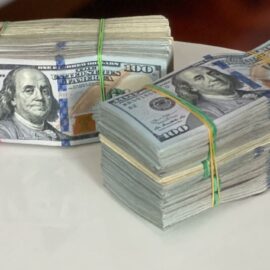

This article is an excerpt from the Shortform book guide to "Rich Dad's Cashflow Quadrant" by Robert T. Kiyosaki. Shortform has the world's best summaries and analyses of books you should be reading.
Like this article? Sign up for a free trial here .
What does it mean to be financially secure? Why is having a job no longer a safe bet for financial security?
According to Robert Kiyosaki, the traditional path to financial security (Education → Good Job → Great Benefits and Pension → Secure Retirement) no longer works. In the 21st century, this path leads to hard work in exchange for job dependency, inadequate retirement, a pernicious debt cycle, tax disadvantages, and diluted savings—not financial security, and almost certainly not financial freedom.
In this article, we’ll discuss five problems with the traditional path to financial security.
Why the Traditional Path to Wealth No Longer Works
According to Kiyosaki, the path to financial security used to be clear. Traditional advice tells us to get a college education and then find a good job in the E or S categories with benefits and a pension. On this path, which we’ll call the traditional path, you could expect to be financially secure for the rest of your life.
To Kiyosaki, that’s a plan that worked in the 20th century.
What You Used To Get on the Traditional Path: Education → Good Job in the E or S Categories → Great Benefits and Pension → Secure Retirement
What You Get On the Traditional Path Today: Debt-Causing and Possibly Not Very Useful Education → Job Dependency in the E or S Categories → More Debt → The Short End of The Stick on Taxes → Inadequate Benefits and Pension → Insecure Retirement
Problem 1: Traditional Education Doesn’t Teach Us the Skills to Achieve Wealth
On the traditional path, higher education was the first step to generating wealth. A college degree led to a job in your field (usually in the E or S categories), and that job was the foundation for financial security.
As we’ll continue to explain, a job on its own is no longer a safe bet for financial security, and almost definitely won’t deliver financial freedom. According to Kiyosaki, education, including higher education, is inadequate for generating wealth in the 21st century for two related reasons:
1. Since, as we noted earlier, we can no longer count on traditional E and S jobs to deliver financial security, the higher education that prepares us for those jobs is no longer a crucial step toward financial security.
2. While financial security (and freedom) is now detached from a job and attached to knowing the skills to succeed in business and investing, we don’t learn these skills from traditional education. Kiyosaki says the financial education we get from our parents and communities, high schools, and college degrees is usually inadequate or wrong.
- Unless our parents are highly financially literate, we inherit their partial and usually bad ideas about managing money. Even if their financial and career advice worked for them, the economic landscape has probably changed significantly since then.
- High schools don’t pick up the slack, either. Personal finance, business and investing, and economics are usually taught as an afterthought, if they’re taught at all.
(Shortform note: One reason financial education in the United States is so poor is a lack of qualified teachers. Nine out of 10 teachers believe students should take a course on personal finance in high school, but nearly two-thirds of teachers did not feel qualified to teach one. And unlike math or language arts, most states don’t require expertise or significant training in personal finance to become a personal finance teacher. For this and other reasons, roughly 60% of American public school students receive less than 15 hours of personal finance instruction during high school.)
Unless we study finance or business, we don’t become financially literate in college, either. While Kiyosaki says we can learn important skills and ways of thinking in college (and advocates that we still get a college education), he says we should not expect that a college degree will lead to a good job or financial security. Further, just getting a college education can land you in tens of thousands of dollars of debt before you’ve even started your working life. As we’ll cover in later sections, debt is a big barrier to financial security and freedom.
(Shortform note: Due in part to the trend known as “degree inflation” where college degrees are required for jobs that don’t actually demand them, a college education may be more necessary than ever for getting a job. At the same time, 57% of Americans say a college degree doesn’t provide its money’s worth. Between 1989, four years before Rich Dad’s Cashflow Quadrant was published, and 2016, the cost of college (adjusted for inflation) nearly doubled.)
Problem 2: There Are Not Enough Good Jobs
In the 20th century, a good job in the E or S category could support a comfortable life with job security and high wages. Now, Kiyosaki says, in addition to the pensions that used to be tied to your job, there are far fewer secure, high-income jobs.
| Discrimination Limited Access to Good Jobs It’s important to note that for much of the 20th century, women and people of color were denied access to secure, high-income jobs in the first place. Part of the reason there are “fewer” of these jobs to go around now is that they were never available to most of the population, and now more people are competing for them. Historical discrimination also explains why a greater share of today’s jobs have inadequate benefits. Today, manufacturing jobs are in decline, while jobs in the service and retail sectors are growing. Because service and retail jobs were historically considered women’s work, they aren’t connected to benefits or high wages the way manufacturing jobs, primarily the purview of men, are. |
Kiyosaki identifies downsizing as one reason there are fewer “good jobs.” Because of cheap labor overseas, a trend toward consolidation in business, and automation, employers are cutting jobs and cutting pay.
- Cheap foreign labor means employers save money when they outsource jobs that used to be held by higher-paid American workers.
- When businesses consolidate, they don’t have to compete as hard for workers and can offer lower wages.
| The Decline of Good Jobs Along with downsizing, many other trends have contributed to the decline of secure, high-income jobs: The rise of the gig economy has increased the number of jobs classified as independent contractor positions, which don’t offer benefits or stable pay. The 1970s marked the beginning of the end for the strong labor laws first established in the 1940s. With labor laws that favor employers over employees, it is now much easier for employers to fight unionization, which strengthens benefits and pay. Economists differ in their opinions on income inequality, but most agree that it’s not good for the average worker. Between 2009 and 2015, top 1% income grew faster than the income of the other 99% of the population in more than forty states. The U.S. Private Sector Job Quality Index (JQE) is a monthly indicator created in 2019 that measures, unlike other common indicators, the quality of new jobs being created. Good jobs, according to the index, offer more than average income, bad jobs offer less. According to the index, more bad jobs have been created since 1990 than good. |
Problem 3: You Can’t Rely on Your Job for a Secure Retirement
One of the biggest advantages to an E category job is a pension. Unfortunately, pensions are one of the major ways financial security has changed from the 20th to the 21st century. You are less likely to have a pension than your parents or grandparents.
The norm has shifted from a defined benefit system to a defined contribution system. In the defined benefit system, you were guaranteed a pension, which meant income for life after you stopped working. In the defined contribution system, you only get what you and your employer contribute during your working years. You’re at risk of running out of income during your retirement. Since you aren’t guaranteed income for life, your pension is susceptible to market forces. In a crash, you could sustain significant losses.
(Shortform note: Until the 1980s, defined benefit pension plans were common. Originally, defined contribution plans were meant to exist alongside defined-benefit plans. Now, just 17% of private-sector workers have pension plans available to them. Companies prefer defined contribution systems because they’re cheaper and easier to manage.)
A 401(k) Is Inadequate
A 401(k) is a common defined contribution plan that, if offered by your employer, allows you to let your employer send a portion of your paycheck into your 401(k) account automatically. Like other defined contribution plans, it isn’t guaranteed in the event of a market crash. Kiyosaki thinks 401(k) plans are woefully inadequate retirement investment because:
- A 401(k) is taxed at a higher rate than long-term capital gains. (Shortform note: Capital gains are the kind of income you generate when you sell an asset, and therefore is B and I category income.)
- You are penalized for taking money out of a 401(k) early.
- The richer you are in retirement, the higher your income bracket, and the higher the taxes you’ll pay.
- The company that executes your 401(k) makes a far greater profit off your investment than you do. (According to Kiyosaki, the company takes 80% of the profit.)
| Most Experts Recommend a 401(k) It’s difficult to substantiate Kiyosaki’s claim that an average 401(k) plan takes 80% of the profit from your investment. In 2019, the average 401(k) plan provider’s profit was 0.45% of the invested assets. A typical rate of return for a 401(k) plan is 6-7%—greater than typical fees taken by the plan executor. In I Will Teach You To Be Rich, Ramit Sethi says a 401(k) is one of the best retirement accounts for three reasons: The money in your 401(k) is pre-tax, which means you won’t be taxed on it until you withdraw it. Since taxes aren’t taken out of your original investment, it will be larger and will compound more. Your employer can match your contribution. It’s automatic—since your contribution is taken from your paycheck, you don’t have to think about it. |
Social Security Can Run Out
While we can still rely on Social Security on paper, Kiyosaki is skeptical that the funds will be there when today’s workers retire.
(Shortform note: Social Security refers to the tax-funded federal programs available once you retire based on earnings from your working life. Politicians and commentators have been making predictions about the solvency of Social Security since its inception. Kiyosaki predicted Medicare, the taxpayer-funded national health insurance program, would be bankrupt by 2017, which didn’t happen. Now, in 2021, experts say Social Security can be paid through 2034 with its current funding.)
Problem 4: Debt and Taxes Are Your Biggest, Hidden Expenses
The traditional path from higher education to a good job to a secure retirement doesn’t account for what Kiyosaki says your two biggest expenses will be in the E and S categories: debt and taxes.
Debt
Mounting debt is one way your job locks you into a bad cycle. The more debt you take on, the more beholden you are to your job, because you need that income to pay back your debt each month. And unfortunately, according to Kiyosaki, the expectations of a good life on the traditional path increase our debt.
As we previously touched on, student loan debt creates job dependency before you’ve even started to work. Because of the often significant bill that comes due after graduation, you’re compelled to start working right away, and work towards a higher paycheck, so you can pay back your loans.
(Shortform note: Average student loan debt in the U.S. is almost $40,000. Between 1989 and 2016, college tuition grew almost eight times faster than wages, and the cost of college tuition doubled or tripled, depending on the kind of school. While many of our parents and grandparents could work their way through a four-year degree, it’s virtually impossible now. On average, it takes borrowers 20 years to pay back their student loans.)
Kiyosaki says since we’re often issued credit cards before we have any financial literacy (and many people never become very financially literate), we’re at risk for spending beyond our means and falling into significant debt. According to Kiyosaki, once we get that job we’ve taken out loans for, fretted over, and worked hard at, we want the material rewards we’ve been conditioned to associate with success and adulthood. We go into debt to pay for rent, furniture, vacations, and cars.
(Shortform note: The average American owes slightly over $8,000 in credit card debt. When 2005 legislation made it more difficult to declare bankruptcy, people used their credit cards to pay their bills, leading to a very significant increase in credit card debt.)
Eventually, we want the biggest debt-creator of all: homeownership. Against traditional wisdom, Kiyosaki thinks of your house as a liability, not an asset. Between your mortgage, property taxes, repairs, and other costs that come with owning your own home, you lose money every year on your home. Kiyosaki wants you to think about this simply: If you’re losing money every month on your home, it’s a liability, not an asset. (We’ll come back to this distinction soon.)
| The Argument That Your Home Actually Is an Asset The argument that your house is a liability and not an asset is one of Kiyosaki’s most contrarian claims. Many experts point out that even though you pay your mortgage and other homeownership expenses each month, every payment gets you closer to owning your home. Even if you never pay off your mortgage fully (though most people do), the greater share of your mortgage you pay off, the greater your equity (the amount of your property you own) and the greater share of the profit you’ll keep when you sell your home. Even more simply, everyone needs a place to live. Buying a home makes more sense than renting for many people because renting builds no equity. |
Finally, if you’re self-employed and your small business fails (which is likely), you’ll not only be out of a job, you’ll also likely be in significant debt.
(Shortform note: Small business owners can designate their businesses as LLCs (limited liability companies) to shield themselves from being personally responsible for business debt. However, it’s possible for a small business owner to personally guarantee an LLC. In that case, there is potential for a small business owner to be personally responsible for their business debt, which can be significant.)
Taxes
Along with debt, taxes are likely your other biggest expense in the E and S category. Kiyosaki makes two main points about taxes:
1. In the United States and most other countries, when your pay jumps, so does your tax bracket. In Kiyosaki’s view, this means the more you earn, the more you’re punished for it. A coda on Kiyosaki’s point on homeownership: Traditional wisdom says that, since you land in a higher tax bracket once you start to make more money, you should buy a bigger house for the tax advantages. In Kiyosaki’s view, all this does is lock you into a position where you’re in more debt and have to work harder to pay it off.
2. The second point Kiyosaki makes about taxes, which is related to the first, is that there are fewer tax benefits in the E and S categories, and far more in the B and I categories. We’ll revisit this in Part 3.
(Shortform note: The U.S. has 7 federal tax brackets with taxation rates ranging between 10 and 37%; the lower your income, the less you pay in taxes. In a progressive tax system like this, wealthier people pay more in taxes and can still maintain a high standard of living, and poorer people can put more of their income toward meeting their needs. Critics, like Kiyosaki, bristle at how much more the wealthy pay in taxes. They argue that high tax rates on the biggest earners drive the wealthy to look for loopholes that end up making their tax bill smaller than it would be with a lower tax rate.)
Problem 5: Inflation Will Dilute Your Savings
If you can manage to save any between debt, taxes, and putting money away for retirement, Kiyosaki is adamant that parking your money is one of the worst things you can do with it. He says when you save money, you’re really just letting it lose purchasing power because money depreciates so rapidly. (The depreciation of money is called inflation; as money loses value, prices rise.) Your $500 in the bank won’t be worth $500 in 10 years. Though money in the bank earns interest, it also loses value because of inflation. Depending on the rate of inflation, you could be losing more value as your money depreciates than you’re gaining through interest.
(Shortform note: Sethi agrees with Kiyosaki that saving your money means you’ll lose some to inflation. For this reason, both authors advocate investing. However, Sethi does not have the same doomsday outlook about the impact of inflation on the economy as a whole as Kiyosaki has. Like most economists, Sethi sees some inflation as a part of a healthy economy.)
Kiyosaki attributes inflation to the full elimination of the gold standard—when the U.S. dollar was pegged to a value in gold—in 1971. (Shortform note: There are no countries today that use a gold standard. Proponents, usually conservative figures like Kiyosaki, argue that gold’s intrinsic value and scarcity makes it a stable value to attach to a currency. Opponents argue that the gold standard was never actually a particularly stabilizing force, and that the era of the gold standard (50 years around the turn of the century) was a relatively stable period for unrelated reasons. Either way, a dollar today is worth about 60% of a dollar in 1998, when Rich Dad’s Cashflow Quadrant was published.)
To help your money retain its value during periods of high inflation, many experts recommend buying bonds. Bonds are loans you make to a corporation or the government, which promises to pay you back the amount of your loan plus interest in a set period of time. In another piece of contrarian advice, Kiyosaki advocates against using bonds to save. Kiyosaki says that because the 2008 financial crash was predicated on unethically rated bonds and bond issuers are no longer in fiscal condition to pay back, bonds aren’t a secure bet anymore.
(Shortform note: In I Will Teach You To Be Rich, Sethi advises using bonds to invest, because they’re more stable than stocks and don’t fluctuate according to the market. Though the 2008 recession was caused by bad bonds, generally in recessions investors turn to bonds for their stability, and, arguably, the 2008 recession was caused by bad actors rather than by bad bonds.)
You Can’t Escape the E and S Cycle by Staying in the E and S Categories
Even if your E or S category job does lead to financial security, with great retirement benefits and high enough pay not to have to worry about money, trading one not-so-bad job for a better job and eventually that much-coveted truly good job doesn’t change the fact that you are still fundamentally constrained by the limitations of your work and the life it defines for you. Financial security is not financial freedom. A job you love and that provides for you and a job you hate and that doesn’t provide for you both define the parameters of your life, even if you’re the boss.
Ultimately, Kiyosaki wants you to take away two main points about the E and S categories:
- Your long-term financial health is your responsibility to create. He says you can’t rely on your employer or the government for security.
- While people seek out the E and S income categories for security, to Kiyosaki, they are in fact a risky bet for financial security and a virtual nonstarter for financial freedom.
| The More Pernicious Low Wage Work Cycle Kiyosaki focuses on jobs that require college degrees and that pay enough for you to put at least some money away for retirement and take on significant debt. He focuses less on low-wage work, which often traps workers in a different and even more pernicious cycle. 44% of the American workforce earns low wage income, a figure that has increased since the 1970s. Low-wage jobs are far less likely to offer any benefits. Low-wage workers are more likely to be laid off because of their lack of attachment, though benefits, to the company. Because of turnover in low-wage jobs, employers have little incentive to invest in training for workers to advance. It’s harder to save money when you make less money. |

———End of Preview———
Like what you just read? Read the rest of the world's best book summary and analysis of Robert T. Kiyosaki's "Rich Dad's Cashflow Quadrant" at Shortform .
Here's what you'll find in our full Rich Dad's Cashflow Quadrant summary :
- Why the traditional path of college to career doesn't work
- Which types of income will lead you to financial freedom
- An in-depth look at Robert Kiyosaki's four cashflow quadrants






